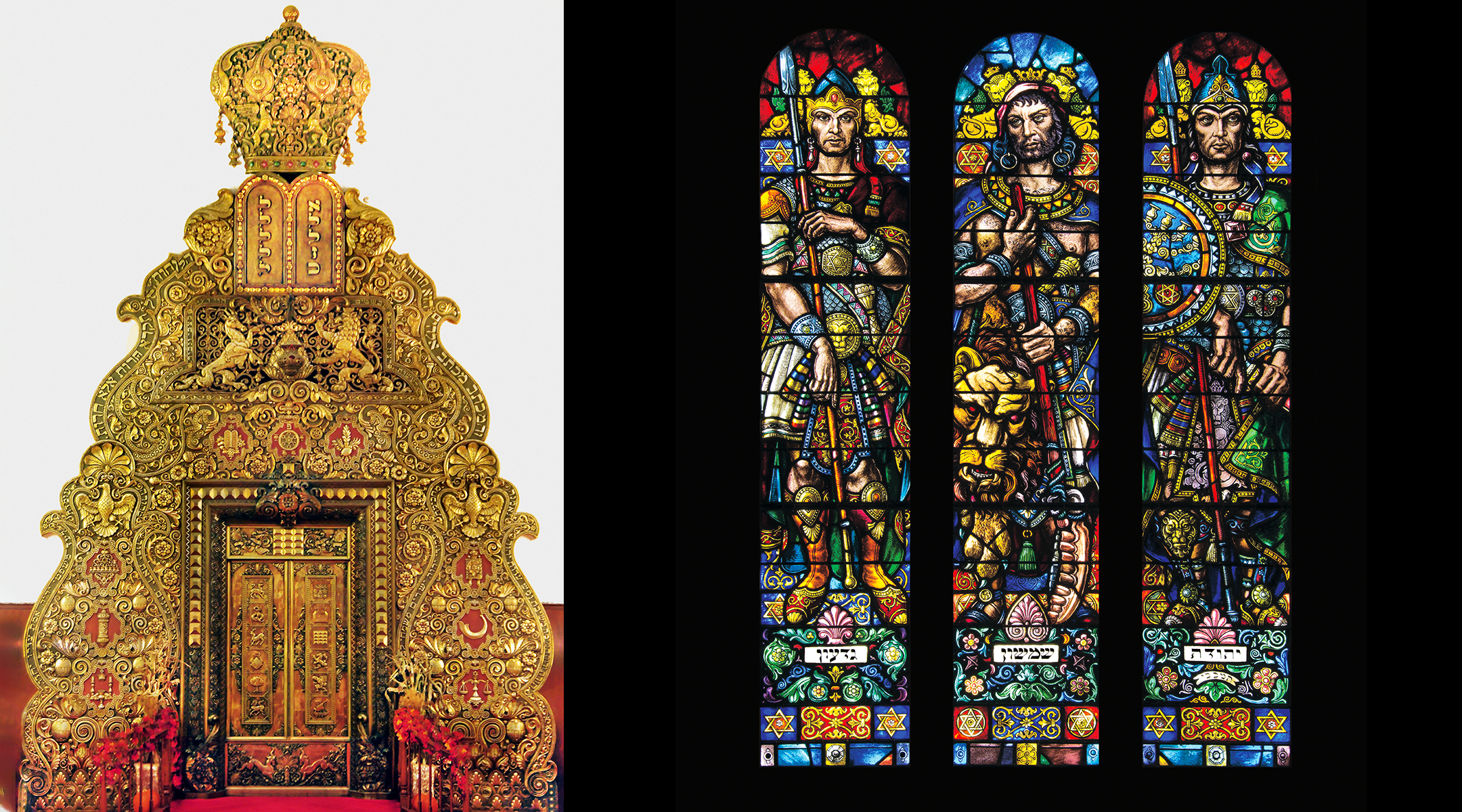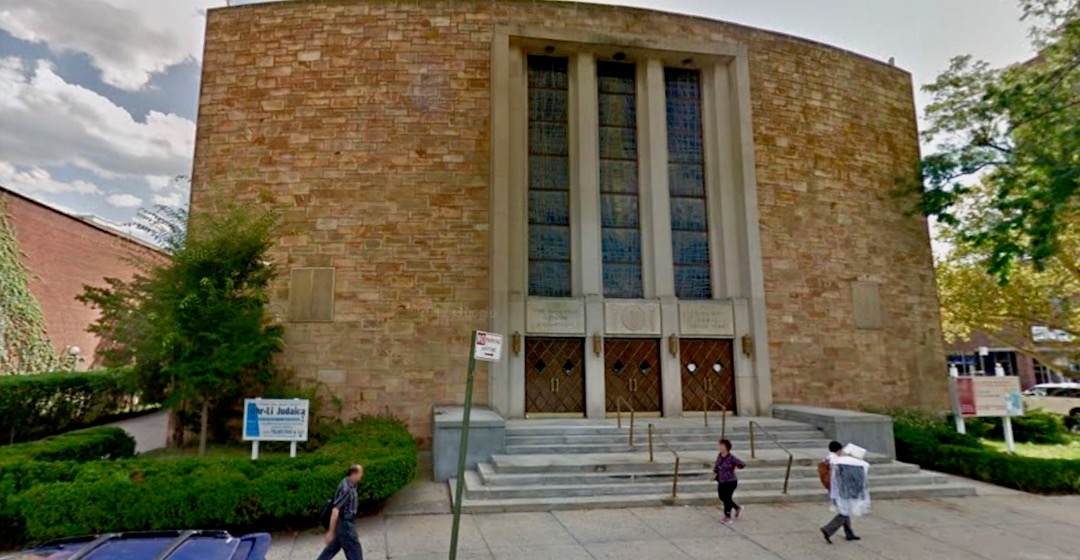A Queens synagogue is moving, and the fate of its storied ark is in limbo
Arthur Szyk’s soaring design at the Forest Hills Jewish Center may be too big for a museum, and out of fashion with current design trends

Rabbi Gerald C. Skolnik, spiritual leader of the Forest Hills Jewish Center, presides over a ceremony in front of the opulent ark designed by the late Polish-born artist Arthur Szyk. (Courtesy FHJC)
(New York Jewish Week) — Crafted of bronze and gold-leaf plaster, and topped by a bejeweled crown, the astonishing 26-foot-tall ark of the Forest Hills Jewish Center fills its cavernous sanctuary with an imposing presence.
When Temma Kingsley joined the congregation as a newlywed in 1965, she was taken aback by its style.
“I thought it was really quite fancy, overdone,” she recalled recently, comparing it to the traditional wooden ark in the modest Philadelphia synagogue where she grew up. “But I’ve since learned what it’s all about, and I’ve become attached to it.”
The ark, which houses the synagogue’s Torah scrolls, is the work of artist Arthur Szyk (1894-1951), a Polish-born artist who rose to fame in the United States with vivid, technicolor drawings on the covers of influential magazines, in the pages of high-profile newspapers and in fine galleries and museums around the world. When the synagogue dedicated its minimalist post-war building on Queens Boulevard in 1949, Szyk’s opulently designed ark stood out as entirely different.
Now, with the impending sale of the Forest Hills Jewish Center building, Kingsley is concerned about the ark’s future. So too are current synagogue leaders, as well as art historians and museum curators, who are scurrying to find it a new home. Meanwhile, the ark’s fate remains in question.
The Conservative synagogue announced last year it was selling its building and would look for a new home in the same area in Queens. In August, an investment partnership led by Joseph Yushuvayev and Uri Mermelstein of Top Rock Holdings announced it was in contract to buy the building and develop the site.
Fully acknowledging the value and importance of the Szyk ark, the congregation is seeking to find it a new home. At least one art dealer has expressed interest in acquiring the ark, but this route has been rejected as it would not come with any guarantee of where it might eventually land.

“What if the buyer decides to disassemble the ark and use its beautiful bronze doors as the entrance to their home?” Deborah Gregor, executive director of the Forest Hills Jewish Center, asked rhetorically, her voice tightening.
Taking into consideration this theoretical scenario, the board has agreed to prioritize keeping the ark intact to honor its legacy. Several museums have been contacted. Thus far none have come forward.
Simona Di Nepi, the Charles and Lynn Schusterman Curator of Judaica at the Boston Museum of Fine Arts, traveled to Forest Hills last month to see the ark and “fell in love.”
“I see it as a tour de force of Jewish art,” she said — a unique and spectacular “show-stopper.”
On her recommendation, the Boston Museum of Fine Arts explored the possibility of acquiring it, but the height ultimately presented logistical challenges that could not be overcome. Di Nepi has now turned her attention to several large synagogues with the hopes of finding one that might adopt it.
“I can’t bear the thought of what will happen if it does not find a home,” she said.
Born in Poland, trained in Paris and influenced by the brief time he spent at Bezalel Art School in British Mandate Palestine, Szyk was known for his vivid Jewish art, biting political cartoons and his portraits of American heroes and European figureheads. In 1941, The Times Literary Supplement wrote that his illuminated Passover haggadah was “worthy to be placed among the most beautiful books that the hand of man has produced.” Reprinted many times in the decades since, it remains a staple in Jewish homes today.
While Szyk’s oeuvre is described by critics as “exquisite,” “masterful” and “marvels of technical skill,” the artist did not view his own creations as ends unto themselves. Instead, he used his work to influence politics and world opinion. Irvin Ungar, editor of the 2017 study “Arthur Szyk: Soldier in Art,” wrote that Szyk employed pen and paintbrush as tools to wage war against the Nazis, attack racism, promote Zionism and preserve freedom.
His work caught the attention of two leading rabbis of his day: Abba Hillel Silver in Cleveland and Ben Zion Bokser in Queens. Both led growing congregations that would reach well over 1,000 family members. Separately, the two commissioned Szyk to create significant objects for their respective synagogues.

Szyk’s stained glass “Warrior Windows” were dedicated in Cleveland’s Reform Temple Tifereth Israel on the last day of Hanukkah in 1947. Commissioned to honor congregants who fought in World War II, the 15 windows include the names of fallen soldiers and showcase the biblical figures Judah Maccabee, Samson and Gideon, resplendent in sumptuous battle dress.
In a letter to Silver, Szyk explained that he would have ordinarily charged $15,000 for the project (the equivalent of $200,000 today). But because Szyk aligned so closely with the rabbi’s ideological mission — Silver was a leading proponent of Zionism — he viewed the job as “a personal favor,” and agreed to a much lower sum of $4,500.
Bokser, a social justice activist whose edition of the Jewish prayer book was a staple of Conservative synagogues for decades, was also drawn to Szyk’s bold, innovative style for the sanctuary of his congregation’s sleek new building on Queens Boulevard. Art historian and Cleveland State University Distinguished Professor Samantha Baskind calls it “sui generis”: Like Szyk’s illuminated manuscripts, the ark’s design packs in a dizzying array of abstract ornaments woven together with Jewish emblems. Scrolls, flowers, acorns and leaves are interspersed with holiday symbols, lions of Judah and representations of the Israelite tribes.
Its baroque form is reminiscent of the arks of Eastern European synagogues that were destroyed in the war. But Szyk was neither mournful nor nostalgic. Forward looking and hopeful, his ark doors are flanked by birds that can be read as either eagles or doves. With their wings spread wide, the figures stretch toward the biblical and Talmudic passages that border the work, invoking God’s judgment and heralding freedom.
Ungar assesses the ark as “an American and a Jewish icon” and a “culmination of [Szyk’s] prayers” as expressed through his art. Gregor refers to it as the artist’s “ark de triomph,” quite literally: “It is Szyk’s own statement of triumph, celebratory and grand,” she said.

Ironically, its grandeur is precisely the source of its uncertain future.
When the Jewish Center’s current building was dedicated in 1949 in the presence of 5,000 guests, its scale was meant to accommodate a growing membership. Its main sanctuary held 1,200 seats, and its religious school would eventually accommodate some 900 students. Now the hulking space has become too large and costly for its 300-400 member families to maintain. The congregation has not yet announced relocation plans. But their hope for the future is an intimate space with a cozy aesthetic, where the monumental scale of the Szyk ark will likely not fit in.
Art historian Samantha Baskind has been preoccupied with the issue. “A logical solution would be to unite it with Szyk’s Warrior Windows” in Cleveland’s Temple Tifereth Israel,” she said. “Bringing the works into conversation with each other in the same sacred space is conceptually brilliant and would honor the memory of Rabbi Silver at the same time that it beautifies the synagogue.”
Whatever the future holds for the ark, some Forest Hills Jewish Center members are finding it hard to say goodbye. Kingsley recalled the central role the synagogue has played in her life since she moved to Forest Hills 57 years ago. For her, the ark is not just about its aesthetic details, or the artist who created it.
“That was the ark Rabbi Bokser commissioned,” she said wistfully. It holds his spirit, too.
Alanna E. Cooper serves as the Abba Hillel Silver Chair in Jewish Studies at Case Western Reserve University. Her book “Disposing of the Sacred” is forthcoming with Penn State University Press.
This article originally appeared on JTA.org.
A message from our Publisher & CEO Rachel Fishman Feddersen

I hope you appreciated this article. Before you go, I’d like to ask you to please support the Forward’s award-winning, nonprofit journalism so that we can be prepared for whatever news 2025 brings.
At a time when other newsrooms are closing or cutting back, the Forward has removed its paywall and invested additional resources to report on the ground from Israel and around the U.S. on the impact of the war, rising antisemitism and polarized discourse.
Readers like you make it all possible. Support our work by becoming a Forward Member and connect with our journalism and your community.
— Rachel Fishman Feddersen, Publisher and CEO























